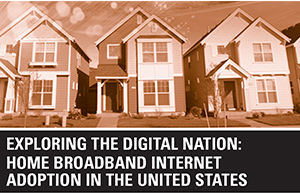Household use of broadband Internet service has risen dramatically during the first decade of the 21st century as the Internet has become integral to the lives of most Americans. Nonetheless, not everyone uses broadband Internet – either by choice or because they lack access. This report, prepared jointly by the Commerce Department’s Economics and Statistics Administration (ESA) and National Telecommunications and Information Administration (NTIA), explores differences in broadband Internet use among households.
Earlier studies by NTIA and others have shown that broadband Internet use varies significantly across households of different socio-economic backgrounds and in different geographic locations. This report builds on the findings of an NTIA report published earlier in 2010 showing that while broadband Internet access rose between 2007 and 2009 for most demographic groups and geographic areas, persistent differences in levels and growth rates remained (NTIA, 2010). That report found highest rates of home broadband Internet use among Asians and Whites, married couples, younger people, urban residents, people with higher incomes, and people with more education. This report expands the analysis presented in the earlier NTIA report to examine these differences in broadband Internet use in greater detail.
This report and the earlier NTIA report used data from a special 2009 supplement to the Census Bureau’s Current Population Survey (CPS), which asked questions about broadband Internet use of more than 50,000 households.

